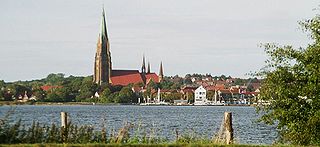
Christian I was a Scandinavian monarch under the Kalmar Union. He was King of Denmark (1448–1481), Norway (1450–1481) and Sweden (1457–1464). From 1460 to 1481, he was also Duke of Schleswig and Count of Holstein. He was the first Danish monarch of the House of Oldenburg.
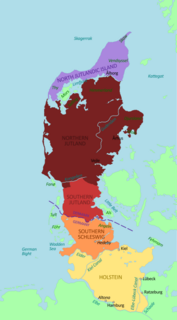
The history of Schleswig-Holstein consists of the corpus of facts since the pre-history times until the modern establishing of the Schleswig-Holstein state.

Eric IV, also known as Eric Ploughpenny or Eric Plowpenny, was king of Denmark from 1241 until his death in 1250. He was the son of Valdemar II of Denmark by his wife, Berengaria of Portugal, and brother of King Abel of Denmark and King Christopher I of Denmark
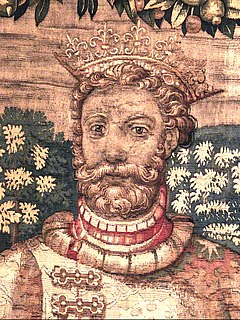
Abel of Denmark was Duke of Schleswig from 1232 to 1252 and King of Denmark from 1250 until his death in 1252. He was the son of Valdemar II by his second wife, Berengária of Portugal, and brother to Eric IV and Christopher I.

Valdemar III (1314–1364) was king of Denmark from 1326 to 1329, while he was underage; he was also Duke of Schleswig as Valdemar V in 1325–26 and from 1330 to 1364. He was a rival king set up against the unsuccessful Christopher II and was widely opposed by his subjects. His term was ended when he abdicated. Sometimes the earlier King Valdemar the Young (c. 1209–1231) is also referred as Valdemar III.
The Treaty of Ribe was a proclamation at Ribe made by King Christian I of Denmark to a number of Holsatian nobles enabling himself to become Count of Holstein and regain control of Denmark's lost Duchy of Schleswig. The most famous line of the proclamation was that the Danish Duchy of Schleswig and the County of Holstein within the Holy Roman Empire, should now be, in the original Middle Low German language, Up Ewig Ungedeelt, or "Forever Undivided". This was to assume great importance as the slogan of German nationalists in the struggles of the 19th century, under completely different circumstances.
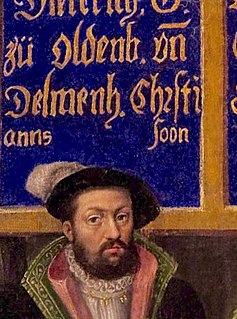
Dietrich or Theoderic of Oldenburg was a feudal lord in Northern Germany, holding the counties of Delmenhorst and Oldenburg. He was called "Fortunatus", as he was able to secure Delmenhorst for his branch of the Oldenburgs.

Gerhard III of Holstein-Rendsburg, sometimes called Gerhard the Great, and in Denmark also known as Count Gert or den kullede greve, was a German prince who ruled Schauenburg and Holstein-Rendsburg and a large part of Denmark during the interregnum of 1332–40.

Helvig of Schleswig, was a Danish Queen consort, spouse of King Valdemar IV of Denmark. She was the mother of Queen Margaret I of Denmark, Norway and Sweden.

Eric I Abelsøn was a Danish nobleman. He was the ruling Duke of Schleswig from 1260 until his death in 1272. He was the second son of King Abel of Denmark, Duke of Schleswig and Mechtild of Holstein.
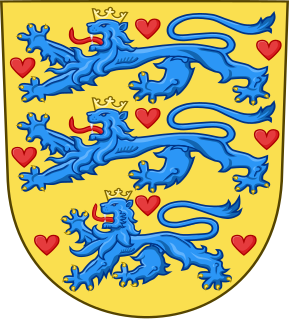
Abel Abelsøn, Lord of Langeland, was the third son of King Abel of Denmark, Duke of Schleswig and younger brother of Valdemar III, Duke of Schleswig and Eric I, Duke of Schleswig. As a member of the ducal family, he held several fiefs in Southern Denmark.

The House of Estridsen, sometimes called the Estridsen or Estrith Dynasty, was the dynasty that provided the Kings of Denmark from 1047 to 1412. The dynasty is named after its ancestor Estrid Svendsdatter. The dynasty is sometimes called the Ulfinger, after Estrid's husband, Ulf the Earl. Their family coat of arms became the coat of arms of Denmark.
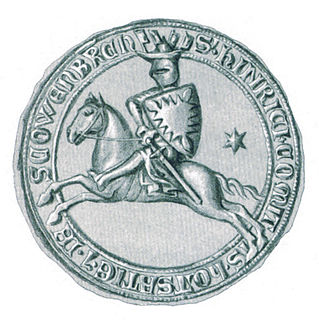
Henry I, Count of Holstein-Rendsburg (1258–1304) was the first Count of Holstein-Rendsburg.
Adelaide of Holstein-Rendsburg, Countess of Schauenburg, was the daughter of Count Henry I and his wife, Helwig of Bronckhorst. One source gives her birthdate as 1299 in Rendsburg, Rendsburg-Eckernforde, Schleswig-Holstein, Germany.
Henry, Duke of Schleswig was Duke of Schleswig from 1364 until his death.










